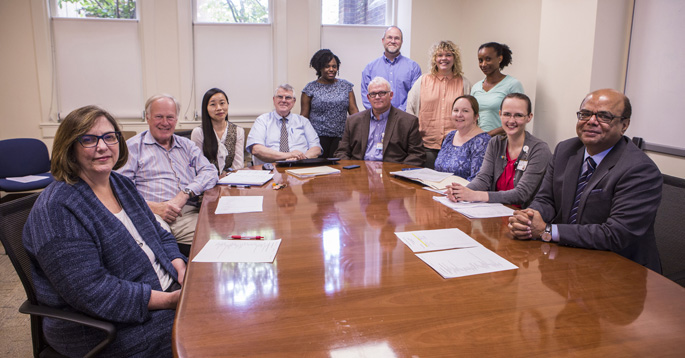
Though the COVID-19 pandemic halted in-person patient visits at Undiagnosed Diseases Network (UDN) sites, including Vanderbilt University Medical Center’s, since March, groundbreaking behind-the-scenes work continues.
VUMC is one of 12 sites around the country selected to be part of a research network to develop effective approaches for diagnosing hard-to-solve medical cases (undiagnosed diseases).
There are an estimated 30 million people in the United States with a rare disease, many of whom don’t have a diagnosis.
Through funding from the National Institutes of Health Common Fund, the 12 sites and four core labs work together to try to solve medical mysteries through team science.
The purpose of the network, formed with an original seven sites, including VUMC, in 2014, is to bring together clinical and research experts from across the United States to solve the most challenging medical mysteries using advanced technologies.
“The UDN is closely monitoring the ongoing pandemic, and its top priority remains the health, safety and well-being of our community and the global community,” according to a statement on the UDN website. “The UDN remains operational with appropriate measures to protect the health of the community.”
Anna Bican, Vanderbilt’s site coordinator, said although a complete temporary shutdown was discussed, the sites agreed they wanted to keep doing whatever they could to gain answers for the patients who need them during the pandemic.
So, the clinical sites remain fully staffed and continue to review applications and receive medical records from those applying to the UDN’s program. In-person evaluations are being delayed, she said.
Each site is doing the DNA sequencing part of the participant work-up first — a model that Vanderbilt and UCLA had each followed in the first phase of NIH funding of the UDN.
Bican said that the Baylor Sequencing Core of the UDN, where Vanderbilt sends its DNA for testing, continued normal operations during the pandemic, allowing the research to continue.
“We’ve still been able to help families by looking carefully through their records virtually and replying back with whether or not they’ve been accepted into the network,” she said.
Bican said a small portion of the patients are actually diagnosed during the chart review process. “You may get a diagnosis or a recommendation of next steps to take toward a diagnosis,” she said.
At least three patients being evaluated by the VUMC site received their diagnosis during the COVID shutdown.
One patient was diagnosed with a fatty oxidative disorder which has an existing treatment. The patient was able to begin the treatment which should help improve weakness and muscle damage.
The reanalysis of another case, which is not always done in many routine clinical cases, identified a diagnosis in a child whose family has long sought out answers for his mysterious medical condition. The child was the second reported case of this new genetic disease.
Another patient had already received a genetic finding from the UDN, but they initially didn’t think that it explained all of her symptoms. The review continued and a new scientific publication affirmed that all of her symptoms were all connected with the genetic finding.
“Sometimes it’s just luck and timing,” Bican said. “Sometimes if a patient’s meeting happened a number of weeks earlier, or if they had been a different patient in the queue, it would go on the unsolved list, and might be found a year or two from now when someone does a reanalysis.”
Bican said the VUMC UDN is meeting its usual metrics (30 patients per year) despite the pandemic.
“While we are not seeing them in person yet, we are doing the first set of DNA sequencing and analysis, which counts as the start of their evaluation. At this point we are not behind in seeing patients, but we expect a bottleneck when it all comes back. We don’t know at this point how it’s all going to turn out, but we are not going to stop looking for answers.”
Bican said that VUMC has been able to use telemedicine in a couple of cases, but there are limitations for the type of patient analysis that is done by each of the UDN sites.
“We were able to evaluate and diagnose the second case of a new disease by telemedicine because of confirming functional studies done by our Structural Biology Group and Dr. (Dan) Roden’s lab,” said John Phillips, MD, professor of Pediatrics, Biochemistry and Medicine and the David T. Karzon Professor of Pediatrics and co-principal investigator of VUMC’s UDN site.
But there have been delays in the process due to COVID.
Intermittent supply chain shortages have affected the blood collection kits that are sent to families for DNA collection, Bican said.
And there has been a significant decline in the number of patients asking the UDN for a medical review, Bican said.
“Something about this outbreak has slowed the number of patients reaching out for help,” she said, adding that it might be because patients are putting off regular medical care during the pandemic and might not be hearing about the opportunity to apply to the UDN.
Since 2014, 202 patients from nine states have been accepted into Vanderbilt’s UDN program.
Overall, the UDN has received 4,582 applications and 1,789 participants have been accepted. Of those, 1,433 have been evaluated and 431 participants have been diagnosed.
Bican said that the five newest hospitals in the UDN network — Children’s Hospital of Philadelphia/University of Pennsylvania, University of Miami, Washington University in St. Louis, University of Washington/Seattle Children’s Hospital and University of Utah — had just begun seeing patients when things were halted due to COVID.
“They had just gotten their feet wet. It’s been very frustrating for some of the new sites joining on,” she said.












